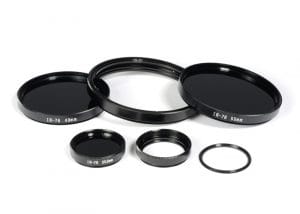High resolution lenses for machine vision — standard and custom lens design
The Benefits of Reflected-UV Imaging
High Resolution Lenses for machine vision, instrumentation, inspection and vibration-sensitive applications. Standard and custom hi-res lens assemblies.
Industrial machine vision has focused on the visible light spectrum and uses visible light illumination and visible light imaging cameras to detect imperfections. The simplest machine vision device can replace human workers; the reason for this is that the human eye can pick up visual cues in the electromagnetic spectrum of wavelengths between 400 and 750 nanometers. The machine vision system could combine a monochrome video camera and a software algorithm to detect items as miniscule as whether the cap on a tube of toothpaste is fully tightened or even cracks in a surface at a subatomic particle levels.
As an inspection modality, ultraviolet (UV) imaging is emerging as a technology of choice. Because UV lights interact with materials in unique ways, it enables the machine vision system to visualize the topology of surfaces without having light penetrate the interior of the object. Because UV lights operate on a short wavelength, smaller inconsistencies can be identified. The machine vision system however needs to be calibrated to distinguish between reflected UV and UV fluorescence. The difference between the two is that reflected UV images begin with the illumination of a surface with UV light which is then scattered, or reflected, toward the camera that has been calibrated to that wavelength. With UV fluorescence imaging the surface being examined is actively illuminated with UV light but in this instance the UV light is made visible in the infrared band.
The most commonly used application for reflected ultraviolet imaging is for the detection of scratches on the surface of an object. Because reflected UV captures images at shorter UV wavelengths it is better able to detected scratches on items such as windows or lenses and can even be utilized in the semiconductor industry to find submicron sized defects. Surface contamination of organic materials such as grease or oil can be detected in deep UV band wavelengths.
Imaging cameras that utilize CCD and CMOS technologies don’t always capture images well in the UV band; the reason for this is that UV light is not a desirable feature in color video cameras. UV sensitivity in CCD cameras can result in an image showing up with purple halos around the object; toward this end, CCD and CMOS cameras are equipped with built-in features that absorb UV rays.
In the calibration of a machine vision instrument it is designed to capture bands in the near-UV and deep-UV wavelength bands. The field of reflected UV imaging continues to emerge and it’s believed there are myriad unearthed applications for the reflected-UV imaging.
